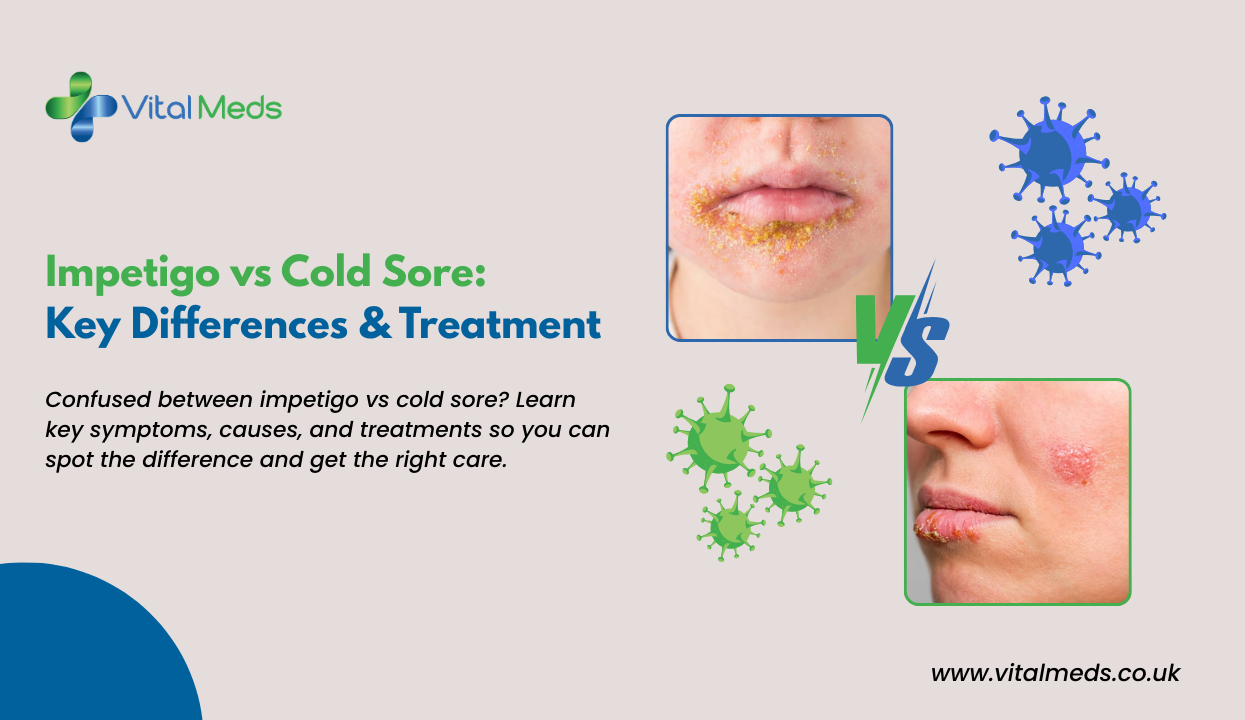- Your cart is empty
- Continue Shopping
Impetigo vs Cold Sore: Key Differences & Treatment

Both Impetigo vs Cold Sore look similar, like crusty or blistery sores around the mouth. Parents worry when a child gets a red spot or sore on the lips. They wonder if it is a cold sore, or an impetigo-like skin infection. Adults may also have difficulty distinguishing between the two when sores suddenly appear.
It is important to understand the differences between the two because they are different in terms of causes, treatments, and risks. Cold sores and impetigo are both bacterial infections that require antibiotics. Impetigo, however, is caused by a viral infection (HSV-1), which often returns due to triggers like stress or sunlight. This guide will explore the differences between the two, the symptoms and the treatment options in the UK. We’ll also discuss when to seek professional assistance.
What is Impetigo?
Impetigo, a bacterial skin infection that is common in the UK and especially among children aged between 2 and 6, is a very common condition. Staphylococcus Aureus or Streptococcus Pyogenes are the bacteria responsible for impetigo. They can enter through small cuts, bites from insects, or patches of eczema. Once inside, bacteria spreads quickly and causes visible sores.
This condition begins with small blisters or red spots that quickly burst, leaving behind honey-coloured crusts. These sores can appear on the hands, nose, mouth or any other exposed area of the body. Impetigo can be spread by direct contact or contaminated clothing, towels, toys, and even towels.
Impetigo can be classified into two types:
- Non-bullous Impetigo is the most common type, characterized by small, yellow-golden crusts.
- Bullous impetigo is less common, but it can often be seen on infants. It causes large fluid-filled blisters which are painful.
Impetigo is usually cured within 2 weeks without treatment. However, with antibiotics, the recovery time is usually 7-10 days.
What are Cold Sores and How Can They Be Treated?
Herpes Simplex Virus 1 (HSV-1) is the cause of cold sores and fever blisters. Cold sores, unlike impetigo which is a bacterial infection, are viral infections. They remain in the body after contracting them. The virus can remain dormant within nerve cells, and reactivate if triggered by stress or fatigue, illness or excessive sun exposure.
Cold sores usually begin as a tingling, burning sensation around your lips or mouth. This is followed by small, fluid-filled blisters. These blisters can burst and leave painful ulcers. They will eventually crust over and heal within 7-14 days.
Cold sores are contagious as well, but they can be spread through close contact, such as sharing razors, lip balms, or kissing. Cold sores are not limited to children. They can occur at any age.
Impetigo vs Cold Sore: How to Tell the Difference
Both conditions may look similar at first glance. This is why they are often confused. Fortunately, there are a few differences that can help you distinguish them.
Location and Appearance
- Impetigo begins as red patches, which then develop into sores or crusts that have a honey-coloured appearance. These sores can appear on the face, hands and any other exposed skin.
- Cold sores are usually found on the lips, or around the mouth. The first sign is a tingling feeling, which then leads to small painful blisters.
Duration
- Impetigo usually lasts 7-10 days after treatment. It rarely returns once it has been treated.
- Cold sores are usually gone in 7-14 days but the virus remains for the rest of your life. This means that outbreaks may return.
Cause and Treatment
- Impetigo, a bacterial infection, is treated with antibiotics either topically or orally.
- Cold sores can be viral and treated with antiviral tablets or creams.
Contagiousness
- Both are contagious. However, impetigo is spread more easily by touch and contaminated items, while cold sores are spread mostly through direct skin to skin or saliva contact.
Symptoms of Impetigo vs Cold Sore
| Impetigo Symptoms | Cold Sores Symptoms |
| Blisters or red sores that burst rapidly. | Before the blisters appear, there may be tingling, burning or itching. |
| After a sore bursts, a crust of honey-coloured or gold color forms. | The blisters are small and painful, filled with a clear fluid. |
| Itching and irritation | Blisters burst leaving superficial ulcers which eventually scab. |
| Sores tend to cluster, particularly around the nose and mouth. | Sometimes, there is a fever or swelling of the glands, but usually, it’s just pain and discomfort. |
| There may be a mild swelling of the lymph nodes nearby. | Stress, illness or the sun can trigger recurrent episodes. |
Treatment Options in the UK
Treating Impetigo
Impetigo is treated in the UK by:
- Topical antibiotic creams, such as fusidic acids, for mild cases.
- Oral antibiotics are prescribed for severe or widespread infections.
- Keep sores covered and clean to prevent spreading.
- You should avoid school, nursery or work for at least 48 hours following the start of treatment or until all sores are healed.
Some pharmacies in the NHS Pharmacy First program can give antibiotics immediately after a consultation without needing to see a GP.
Treating Cold Sores
Antiviral medications can speed up the healing process and reduce outbreaks. You can choose from:
- Apply antiviral creams like acyclovir and penciclovir at the tingling phase for best results.
- Antiviral tablets are recommended for those who suffer from frequent viral infections.
- Pain relief options like paracetamol, ibuprofen, or numbing gels.
- To prevent the spread of an outbreak, avoid kissing or close contacts.
Prevention Tips
| Impetigo prevention | Cold Sores: How to Prevent Them |
| Handwashing is a good way to maintain good hygiene. | Avoid sun-induced outbreaks by using lip balms with SPF. |
| To avoid splintering, keep your nails clean and short. | Stress can be managed through relaxation, healthy living, and sleep. |
| Cuts, insect bites or scrapes should be treated immediately. | When a cold sore appears, avoid kissing and sharing utensils. |
| Share personal items such as towels, bedding or razors. | If outbreaks are severe or frequent, take antiviral medications. |
When to Seek Medical Help
If you are experiencing any of the following:
- The impetigo spreads quickly or does not heal after a few days.
- Children are more susceptible to impetigo.
- Cold sores are very common or can be severe.
- When cold sores reach the eyes, they are called ocular herpes. This is a medical crisis.
- Both conditions are accompanied by a fever, swollen lymph glands or increasing pain.
Our pharmacists at VitalMeds UK can provide NHS or Private prescriptions and arrange convenient delivery.
Conclusion
Although impetigo may appear similar to cold sores, they are different in their origin and treatment. Impetigo vs Cold Sore are both bacterial infections that require antibiotics. Impetigo, however, is viral in nature and requires antivirals. By knowing the difference, you can ensure that the correct care is provided at the appropriate time.
FAQ
Both can occur around the mouth. Impetigo is usually a honey-coloured crust, whereas cold sores start as blisters and scabs. Professional confirmation is possible with a professional check.
Both are contagious, but they spread in different ways. Cold sores are spread by kissing or sharing items. Impetigo is spread by direct contact.
Impetigo is usually cleared in 7-10 days when treated with antibiotics. Cold sores can last for 7-14 days, but they can recur due to triggers like stress, fatigue or sun.
If your immune system is weak, it’s possible but rare. It’s important to have a diagnosis because treatments vary.
If sores spread quickly, don’t improve, or cause severe discomfort, seek help. If the condition is serious, a doctor should be consulted. A pharmacist can provide advice on treatment.

